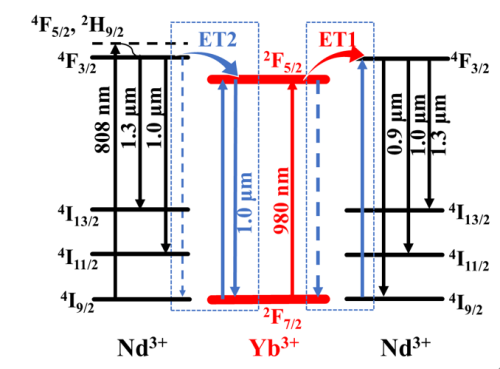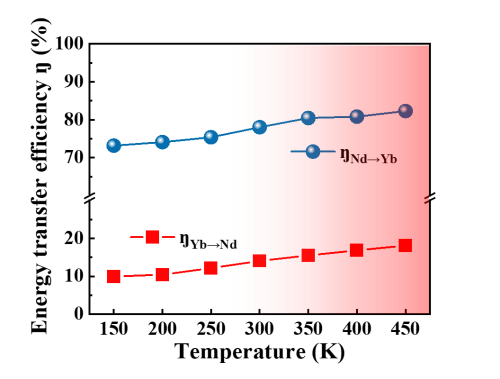The High Power Laser Unit Technology Laboratory of Shanghai Institute of Optics and Fine Mechanics (SIOM) of the Chinese Academy of Sciences (CAS) has made progress in the effect of temperature on Nd3+/Yb3+ energy transfer. The research team found that in Nd3+/Yb3+ co-doped silicate glass, the energy transfer of rare earth ions increases with Changes in temperature, related research results were published online in Journal of Luminescence on July 18, 2022.
Nd3+ and Yb3+ are two widely used rare earth elements, but due to the excited state absorption of Nd3+, multi-phonon relaxation, cross relaxation, and single absorption band of Yb3+, the temperature sensitivity limits the further development of both.
But when the two are mixed, they can make up for each other's shortcomings. The energy difference between the 4F3/2 energy level of Nd3+ and the 2F5/2 energy level of Yb3+ is about 1000cm-1, which is easily affected by temperature and leads to changes in the energy transfer direction and efficiency of the two.
Therefore, researchers believe that it is an important direction and focus to exploring the effect of temperature on Nd3+/Yb3+ energy transfer.
The research team characterized the variation of Nd3+/Yb3+ energy transfer with temperature using phonon energy and density, temperature-variable fluorescence spectrum, and temperature-variable fluorescence lifetime.
The study shows that in silicate glass, the phonon with an energy of 621cm-1 is beneficial to the energy transfer of Nd3+→Yb3+, while the phonon with an energy of 1090cm-1 is beneficial to the energy transfer of Yb3+→Nd3+. Furthermore, as the temperature increases, the phonon density increases, which is beneficial to the energy transfer between the two.
In addition, in the temperature range from 150K to 300K, the energy transfer of Nd3+ →Yb3+ increases from 73.19% to 82.31%, and the energy transfer of Yb3+→Nd3+ increases from 9.97% to 18.11%. In addition, in the case of co-doping, the effective line width at 1 μm of both is effectively expanded, and the effective line width at 1 μm at room temperature reaches 89.1 nm.
The leader of the team said, “the results of this study lay a solid foundation for the application of Nd3+/ Yb3+ co-doped silicate glass.”

Fig. 1 The energy transfer of Nd3+←→Yb3+. (Image by SIOM)

Fig.2 Energy transfer efficiency of Nd3+/Yb3+ at different temperatures. (Image by SIOM)
Article website:
https://doi.org/10.1016/j.jlumin.2022.119146
Contact:
WU Xiufeng
General Administrative Office
Shanghai Institute of Optics and Fine Mechanics, CAS
Email: xfwu@siom.ac.cn
Web: http://english.siom.cas.cn/